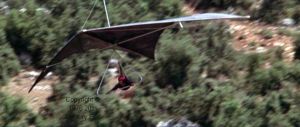Home (contents) → Miscellaneous → Appliance of statistics
Appliance of statistics
Progress in hang glider technology is only half the story. In 1975 it became clear that pilots were making easily avoidable mistakes that were sometimes fatal. The parents of the Wills family that created the Wills Wing hang glider manufacturer had already had one son killed. Young Eric attempted to teach himself 360 degree turns when his two older brothers Chris, the first US champion, and Bob, the reigning champion, were away. Eric ran out of room and collided with the hillside.
Intermediate syndrome

In preparation for the meeting I had reduced all the known fatal accidents for the past six months (August to February) to the little pink 3″ x 5″ cards we will use for the data bank.
— Robert V. Wills, The Intermediate Syndrome: A Dangerous Confidence, in the USHGA magazine Ground Skimmer, March 1975.
We still use the term intermediate syndrome. However, while the ‘data bank’ was later computerised, we struggled to communicate and integrate incident data across national boundaries, even among English-speaking nations, until after the turn of the century. Moreover, more than 40 years on from 1975, we still find it hard to persuade pilots to complete incident report forms, which are nowadays available online.

Our family was fortunate enough to attend the British national competition in Mere, [Wiltshire], England this past August and there were no serious injury accidents in four days of flying by hundreds of flyers. …somewhere between ten and twenty thousand people came to watch the meet over a hundred miles from London, with marginal wind and only a 200′ hill, but with major sponsorship and lively commentary.
— Robert V. Wills in Ground Skimmer, October 1975
Accident reporting was not particularly efficient in 1975, despite Wills’ efforts, which included a network of hang glider pilots sending in summaries from several countries and his own perusing of hang gliding magazines from around the world. An accident he missed on this occasion was a standard Rogallo that stalled too high on final approach to the hot and dusty landing field. It dived automatically in recovering from the stall and it was flying almost horizontally, but too fast for a safe landing, when the control frame base tube made contact with the ground. This author was nearby and he ran towards the crash, hoping that somebody else would get there first, which they did. (Fortunately, a qualified first aider.) The pilot’s right wrist was badly broken.
A serious consequence of poor information flow, which this USHGA initiative sought to address, is illustrated by the threat posed by an apparently trivial thing; lace hooks in hiking boots. See Lace hooks in Dangers of hang gliding.
BHPA club coaching scheme
Statistics in Britain revealed in the early 1980s that newly trained hang glider pilots were suffering a high rate of crashes and injuries after they left the training schools. It was a clear case of intermediate syndrome.
An example: In 2010 this author stayed a night with B&B accommodation offered by a former RAF C-130 pilot and his wife. He had learned to fly hang gliders in 1983 and, after obtaining his club pilot rating (whatever it was called then) he borrowed a friend’s PacWind/Hiway Vision and went to a large hill in south Wales to fly on his own. He crashed on launch, wrecking the glider, but luckily without injuring himself. He never again flew a hang glider.
The RAF has direct experience of intermediate syndrome. Here is Roald Dahl, author of the chocolate factory stories, writing about his first flight in a fighter aircraft, after training in Africa in World War 2:
I remember thinking at the time that this was surely not the right way to do things. They had spent eight months and a great deal of money training me to fly and suddenly that was the end of it all. Nobody in Ismalia was going to teach me anything about air-to-air combat, and they were certainly not going to take time off to instruct me when I joined a busy operational squadron. There is no question that we were flung in at the deep end, totally unprepared for actual fighting in the air, and this, in my opinion, accounted for the very great losses of young pilots that we suffered out there.
— Roald Dahl, Going Solo, 1986
To counter intermediate syndrome, the BHGA instigated a club coaching scheme. Nowadays, when a pilot obtains his wings from a hang gliding school, he is handed over to a the coaches of the hang gliding club that he joins. Coaches are all trained in a two- or three-day club coaching course and are ratified annually in that role by the club’s chief coach.
Related
Sport Kites/Wills Wing of California